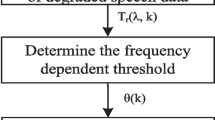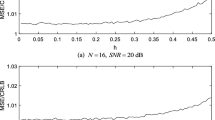Abstract
The standard proportionate normalized least mean square (PNLMS) adaptive algorithm suffers from convergence performance limitation due to a constant step-size during the convergence period. In this paper, a switching-based variable step-size PNLMS is proposed to improve the convergence performance in sparse system identification. To adjust the step-size, the convergence performance of PNLMS is first analysed in the statistical sense and by exploiting the analysis, a switching-based method is then proposed, which brings about a fast convergence towards the desired steady-state mean-square weight deviation. The step-size reduces during the convergence period in a few steps, while in the case of abrupt change in the system impulse response, the step-size increases to its initial value. A sub-band version of the proposed adaptive algorithm is further proposed for highly correlated input signals. Simulation results confirm the superiority of the proposed full-band and sub-band algorithms in terms of convergence performance compared to some competing adaptive algorithms.












Similar content being viewed by others
Code Availability
Source codes of the proposed VSS-PNLMS algorithm are publicly available at https://doi.org/10.5281/zenodo.8180278.
Data Availability
The datasets generated during and/or analysed during the current study are available from the corresponding author on reasonable request.
Notes
Matlab codes of VSS-PNLMS for this simulation are available in [7].
References
U.M. Al-Saggaf, M. Moinuddin, M. Arif, A. Zerguine, The q-least mean squares algorithm. Signal Process 111, 50–60 (2015)
S. Attallah, The wavelet transform-domain LMS adaptive filter with partial subband-coefficient updating. IEEE Trans. Circuits Syst. II: Express Briefs 53(1), 8–12 (2006)
Audio and Communications Signal Processing Group, Institute of Telecommunications and Multimedia Applications. https://gtac.webs.upv.es/index.php
M. Bekrani, A W.H. Khong, A delayless sub-band PNLMS adaptive filter for sparse channel identification, in 28th Iranian Conference on Electrical Engineering (ICEE), (IEEE, 2020), pp. 1–6
M. Bekrani, A.W.H. Khong, M. Lotfizad, A clipping-based selective-tap adaptive filtering approach to stereophonic acoustic echo cancellation. IEEE Trans. Audio Speech Lang. Process 19(6), 1826–1836 (2011)
M. Bekrani, M. Lotfizad, Clipped LMS/RLS adaptive algorithms: analytical evaluation and performance comparison with low-complexity counterparts. Circuits Syst. Signal Process 34(5), 1655–1682 (2015)
M. Bekrani, Z. Mohagheghian-Bidgoli, Matlab codes for VSS-PNLMS. (2023) Available OnLine: https://doi.org/10.5281/zenodo.8180278
M. Bekrani, H. Zayyani, A weighted soft-max PNLMS algorithm for sparse system identification. Int. J. Inf. Commun. Technol. Res. 8(3), 7–14 (2016)
J. Benesty, S.L. Gay, An improved PNLMS algorithm, in IEEE International Conference on Acoustics, Speech, and Signal Process. (ICASSP), USA (2002), pp. II-1881–II-1884
J. Benesty, Y. Huang, Adaptive signal processing—applications to real-world problems (Springer-Verlag, Berlin, 2003)
N.J. Bershad, J.C.M. Bermudez, A switched variable step size NLMS adaptive filter. Digit. Signal Process 101, 102730 (2020)
S. Chen, F. Gu, C. Liang, H. Meng, K. Wu, Z. Zhou, Review on active noise control technology for \(\alpha \)-stable distribution impulsive noise. Circuits Syst. Signal Process 41, 956–993 (2022)
S. Ciochina, C. Paleologu, J. Benesty, An optimized NLMS algorithm for system identification. Signal Process 118, 115–121 (2016)
S.H. Dandach, F. Baris, S. Dasgupta, B.D.O. Anderson, Adaptive source localization by mobile agents, in Proceedings of the 45th IEEE Conference on Decision and Control (2006), pp. 2045–2050
H. Deng, M. Doroslovacki, Improving convergence of the PNLMS algorithm for sparse impulse response identification. IEEE Signal Process. Lett 12(3), 181–184 (2005)
P.S.R. Diniz, G.O. Pinto, A. Hjorungnes, Data selective partial update affine projection algorithm, in IEEE International Conference on Acoustics, Speech, and Signal Process. (ICASSP) (2008), pp. 3833–3836
Y. Dong, Z. Zheng, Set-membership proportionate NSAF algorithm with individual activation factors, in 3rd IEEE International Conference on Computer and Communications (ICCC), pp. 1579–1583 (2017)
D.L. Duttweiler, Proportionate normalized least-mean-squares adaptation in echo cancelers. IEEE Trans. Speech Audio Process 8(5), 508–518 (2000)
M.S. Esfand-Abadi, Proportionate normalized subband adaptive filter algorithms for sparse system identification. Signal Process 89, 1467–1474 (2009)
M.S. Esfand-Abadi, S. Kadkhodazadeh, A family of proportionate normalized subband adaptive filter algorithms. J. Frank. Inst. 348(2), 212–238 (2011)
B. Farhang-Boroujeny, Adaptive filters: theory and applications, 2nd edn. (John Wiley and Sons, New York, 2013)
M. Guilin, F. Gran, F. Jacobsen, F. Agerkvist, Adaptive feedback cancellation with band-limited LPC vocoder in digital hearing aids. IEEE Trans. Audio Speech Lang. Process 19(4), 677–687 (2011)
Y. Han, Y. Li, Mixed error variable step-size algorithm with constrained function. Circuits Syst. Signal Process 41, 5307–5318 (2022)
S. Haykin, Adaptive filter theory, 4th edn. (Prentice-Hall, New Jersey, 2002)
F. Hoseiniamin, H. Zayyani, M. Korki, M. Bekrani, A low complexity proportionate generlized correntropy-based diffusion LMS algorithm with closed-form gain coefficients. IEEE Trans. Circuits Syst. II: Express Briefs 70(7), 2690–2694 (2023)
H.C. Huang, J. Lee, A new variable step size NLMS algorithm and its performance analysis. IEEE Trans. Signal Process 60(4), 2055–2060 (2012)
F. Huang, Z. Xie, S. Zhang, Sparse Bayesian least-mean-squares algorithm. IEEE Trans. Circuits Syst. II. Exp. Briefs 70(7), 2710–2714 (2023)
F. Huang, J. Zhang, S. Zhang, Mean-square-deviation analysis of probabilistic LMS algorithm. Digit. Signal Process 92, 26–35 (2019)
J.H. Husøy, M.S. Esfand-Abadi, On the convergence speed of the normalized subband adaptive filter: Some new insights and interpretations, in Proc (International Symposium on Signals, Circuits and Systems, Romania, 2017)
Z. Jin, Y. Li, Y. Wang, An enhanced set-membership PNLMS algorithm with a correntropy induced metric constraint for acoustic channel estimation. Entropy 19(6), 281 (2017)
A.W.H. Khong, P.A. Naylor, J. Benesty, A low delay and fast converging improved proportionate algorithm for sparse system identification. EURASIP J. Audio Speech Music Process. 2007, 1–8 (2007)
K.A. Lee, W.S. Gan, Improving convergence of the NLMS algorithm using constrained subband updates. IEEE Signal Process Lett. 11(91), 736–739 (2004)
K.A. Lee, W.S. Gan, S.M. Kuo, Subband adaptive filter: theory and implementation (Wiley, Chichester, 2009)
A. Mader, H. Puder, G. Schmidt, Step-size control for echo cancellation filters—an overview. Signal Process 89(9), 1697–1719 (2000)
D.G. Manolakis, V.K. Ingle, S.M. Kogon, Statistical and adaptive signal processing (Artech, MA, USA, 2005)
K. Mayyas, F. Momani, An LMS adaptive algorithm with a new step-size control equation. J. Frank. Inst. 348(1), 589–605 (2011)
K. Nishikawa, H. Kiya, New structure of affine projection algorithm using a novel subband adaptive system, in Proc (Third Workshop on Signal Processing Advances in Wireless Communications, China, 2001), pp. 364–367
A. Sadiq, S. Khan, I. Naseem, R. Togneri, M. Bennamoun, Enhanced q-least mean square. Circuits Syst. Signal Process 38(10), 4817–4839 (2019)
A. Sadiq, I. Naseem, S. Khan, M. Bennamoun, A novel quantum calculus-based complex least mean square algorithm (q-CLMS). Appl. Intell. 53(2), 1350–1369 (2023)
A.H. Sayed, Adaptive filtering (Wiley-IEEE Press, New York, 2008)
A. Singer, J. Nelson, S. Kozat, Signal processing for underwater acoustic communications. IEEE Commun. Mag. 47(1), 90–96 (2009)
F.C. Souza, O.J. Tobias, R. Seara, D.R. Morgan, A PNLMS algorithm with individual activation factors. IEEE Trans. Signal Process 58(4), 2036–2047 (2010)
E. Vlachos, A.S. Lalos, K. Berberidis, Stochastic gradient pursuit for adaptive equalization of sparse multipath channels. IEEE. J. Emerg. Sel. Top. Circuits Syst. 2(3), 413–423 (2012)
W. Xia, Y. Wang, A variable step-size diffusion LMS algorithm over networks with noisy links. Signal Process 148, 205–213 (2018)
Y. Yu, H. Zhao, R.C. Lamare, L. Lue, Sparsity-aware subband adaptive algorithms with adjustable penalties. Digit. Signal Process 84, 93–106 (2019)
V. Zarzos, A.K. Nandi, Adaptive blind source separation for virtually any source probability density function. IEEE Trans. Signal Process 48(2), 477–488 (2000)
Y. Zhang, N. Li, J.A. Chambers, Y. Hao, New gradient-based variable step size LMS algorithms. EURASIP J. Adv. Signal Process 2008, 529480 (2008)
H. Zhao, Y. Yu, S. Gao, X. Zeng, Z. He, Memory proportionate APA with individual activation factors for acoustic echo cancellation. IEEE/ACM Trans. Audio Speech Lang. Process 22(6), 1047–1055 (2014)
Author information
Authors and Affiliations
Corresponding author
Ethics declarations
Conflict of interest
The authors declare no conflict of interest.
Additional information
Publisher's Note
Springer Nature remains neutral with regard to jurisdictional claims in published maps and institutional affiliations.
Appendices
Appendix A: Stochastic Analysis of PNLMS Convergence Behaviour for Gaussian Inputs
1.1 Transient Analysis
Substituting (17) and (1) into (2) gives
where \({\textbf{v}}(n)={\textbf{w}}(n)-{\textbf{h}}(n)\). Subtracting \({\textbf{h}}(n)\) from both sides of (6) and using (20) yields
Then, post-multiplying (21) by its transpose and taking its average yields
where \( {{\textbf {K}}}_{vv}(n)=E\left[ {\textbf{v}}(n){\textbf{v}}^T(n)\right] \). Equation (22) is obtained using independence theory which assumes the weights \({\textbf{w}}(n)\) are statistically independent from \({\textbf{x}}(n)\).
To simplify (22), we define \(\tilde{{{\textbf {K}}}}_{vv}(n)={{\textbf {G}}}(n){{\textbf {K}}}_{vv}(n){{\textbf {G}}}(n)\) and hence the fourth term in the right side of (22) can be simplified as
where \(\tilde{{{\textbf {R}}}}_x(n)=E\left[ \frac{{\textbf{x}}(n){\textbf{x}}^T(n)}{{\textbf{x}}^T(n){{\textbf {G}}}(n){\textbf{x}}(n)} \right] \). The equality in (23) is true for zero-mean Gaussian inputs \({\textbf{x}}(n)\) [35] (Eq. (10.4.26)). As a result, (22) can be rewritten as
To further proceed, we define the MSD criterion as
Thus, taking the trace of both sides of (24) and using the definition in (25) yields
To proceed with the study of the MSD behaviour of PNLMS, we employ the following approximations
Substituting (27)–(30) into (26) gives
where
Equation (31) provides a recursion for MSD of the PNLMS algorithm for both time-invariant and time-varying systems.
1.2 Steady-State Analysis
Proceeding with (31), the steady-state MSD is given by
where
and the matrix \({{\textbf {G}}}_\text {ss}\) denotes the steady-state value of \({{\textbf {G}}}(n)\). In addition, \({\tilde{\sigma }}_x^2\) and \({\hat{\sigma }}_x^2\) are the steady-state values of \({\tilde{\sigma }}_x^2(n)\) and \({\hat{\sigma }}_x^2(n)\).
Appendix B: Derivation of the Step-Size of VSS-PNLMS
For the estimation of the steady-state MSD, \(\xi _{\textrm{ss}}\), of PNLMS in (34), \({{\textbf {G}}}_\text {ss}\) is required. Taking into account the fact that \({{\textbf {G}}}_\text {ss}\) is unknown during the convergence of the PNLMS algorithm, the updates of \({{\textbf {G}}}(n)\) at \(n_i\) could be used. Thus we define
Assuming \(\sigma _q^2=0\), and substituting (32) and (33) into (35) for \(i=1,\ldots , K-1\) and \(n_{i-1}< n\le n_i\), yields
subject to the fact that the denominator term in (36) should be positive. As a consequence, the following upper bound for step-size is derived:
In addition, similar to the derivation of (35) and using (36), \(\xi _{\textrm{ss},1}\) can be defined as
Thus, assuming \({{\textbf {G}}}(0)= {{\textbf {I}}}/N\), (37) is simplified to
Therefore, knowing \(\xi _{\textrm{ss}}\) and \(\xi _{\textrm{ss,1}}\), the value of \(\xi _{\textrm{ss},i}\) and accordingly, \(n_i\) for all transients will be calculated using (7) and (8), respectively.
Solving (36) for \(\mu (n)\), yields
Besides, in time-varying scenarios when \(\sigma _q^2\ne 0\), in a similar manner, substituting (32) and (33) into (35) and solving (35) for \(\mu (n)\) in the interval \(n_{i-1}<n\le n_i\) and \(i=2,\ldots ,K\), yields
where
Rights and permissions
Springer Nature or its licensor (e.g. a society or other partner) holds exclusive rights to this article under a publishing agreement with the author(s) or other rightsholder(s); author self-archiving of the accepted manuscript version of this article is solely governed by the terms of such publishing agreement and applicable law.
About this article
Cite this article
Mohagheghian Bidgoli, Z., Bekrani, M. A Switching-Based Variable Step-Size PNLMS Adaptive Filter for Sparse System Identification. Circuits Syst Signal Process 43, 568–592 (2024). https://doi.org/10.1007/s00034-023-02490-4
Received:
Revised:
Accepted:
Published:
Issue Date:
DOI: https://doi.org/10.1007/s00034-023-02490-4




